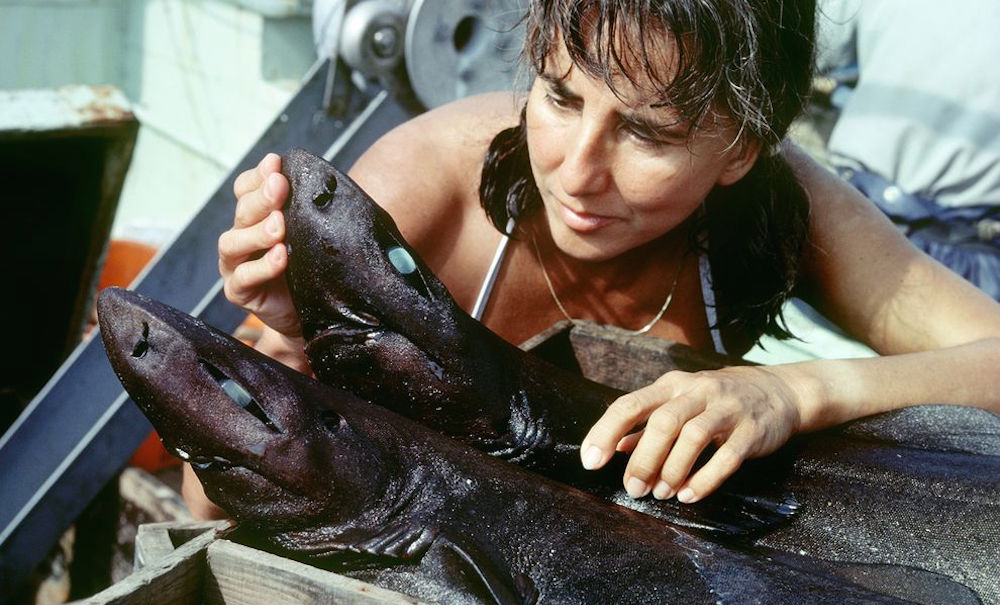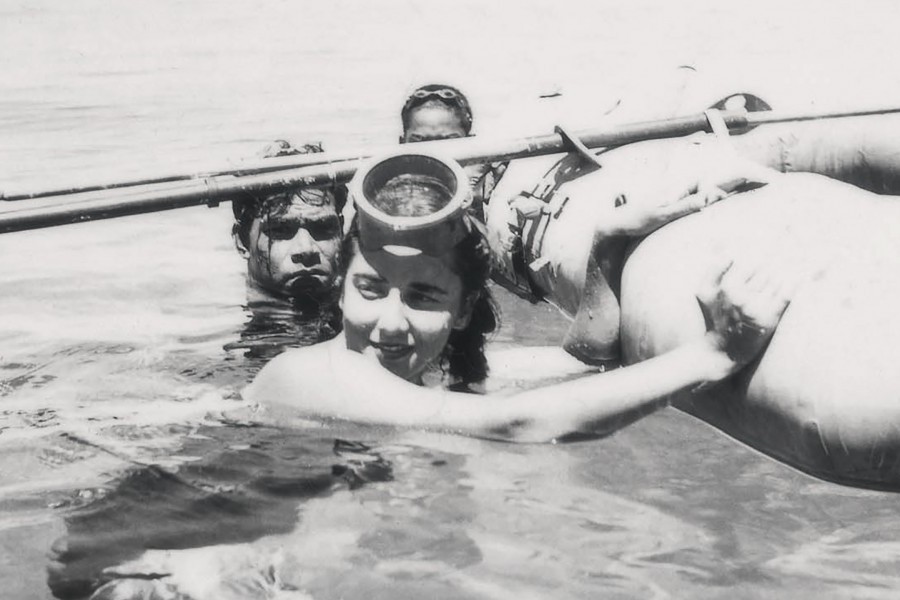TBT: Super Awesome People™ in History.
The 2020 edition of Discovery Channel’s Shark Week starts August 9, and to continue this week’s animals theme (and tie into the longest-running cable television programming event in history), I present Dr. Eugenie Clark: The Shark Lady.
“People come to me and say what’ll I do if I go in the water and see a shark? You don’t have to do anything. The chances of that shark attacking you in any way is so remote. The sea should be enjoyed, the animals in it. When you see a shark underwater, you should say how lucky I am to see this beautiful animal in his environment.”
Dr. Eugenie Clark, The Sharks (1982, National Geographic Video)

Eugenie Clark, 1951 (American Museum of Natural History) 
Eugenie Clark (Photograph by David Doubilet)
Eugenie Clark was born on May 4, 1922 to an American father and Japanese mother. By the age of nine, she was already obsessed with marine animals, and she spent every Saturday at the New York Aquarium (in its original Castle Clinton location). She even “persuaded her mother to buy her a 15-gallon tank and kept fish, toads, snakes and a small alligator at home.” Clark earned a BA in Zoology at Hunter College in 1942, and an MA and Doctorate of Zoology at New York University (1946, 1950) after being rejected from Columbia University’s graduate school out of concerns she would abandon a career in science to start a family.
Although Eugenie Clark’s family life included five husbands and four children, she never left the ocean, and over the course of her 75-year career, she conducted 72 submersible dives (up to 12,000 feet) and countless scuba dives, and led over 200 field research expeditions around the world. She made her last dive in June 2014 at the age of 92, less than a year before her death from non-smoker lung cancer on February 25, 2015.
“She never outgrew the absolute fascination of looking and seeing and observing under water. Even when I was a younger man and she was older, I couldn’t keep up with her. She moved with a kind of liquid speed underwater.”
National Geographic photographer David Doubilet, about Eugenie Clark
At a time when “most ichthyologists were cataloging dead fishes”, ‘Genie’ learned to dive and studied living fish in their natural environment and in the laboratory. In 1949 while working on her PHD, Clark joined a Pacific Science Board project to study poisonous fish species around the Pacific Islands of Micronesia. After earning her Doctorate, she received a Fulbright Scholarship to study ichthyology at the Marine Biological Station in Hurghada on the northern Red Sea Coast of Egypt. These experiences became the focus of her first book, a memoir entitled Lady With a Spear (1953).
In 1954, philanthropists Anne and William Vanderbilt approached Clark with a proposal to open a marine lab in Placida, Florida, after being inspired by her descriptions of a similar Egyptian lab in her memoir. In 1955, the original Cape Haze Marine Laboratory was established as a one-room building where Dr. Clark could conduct her research as the lab’s Founding Director. Within a few years, the success of the lab prompted a move to a larger facility in Sarasota where visiting scientists could travel and collaborate. In 1967 Bill Mote (and his sister Elizabeth) stepped in as new benefactors and the laboratory was transformed from a field station into a major research center. To this day, the renamed Mote Marine Laboratory is still going strong at 65 years.
“[Dr. Clark] is the mother of us all. She was not just the first female shark biologist, she was one of the first people to study sharks.”
Dr. Toby Daly-Engel, a discoverer of Squalus clarkae (‘Genie’s Dogfish’)

(Mote Marine Laboratory & Aquarium) 
(Mote Marine Laboratory & Aquarium)
Dr. Clark published more than 175 articles in scientific journals and mainstream magazines. Her research expeditions took her to the Red Sea, the Caribbean, Papua New Guinea, Thailand, Japan, Palau, Borneo, and the Solomon Islands. She was a pioneer in the use of scuba to conduct underwater research and trained large sharks to press targets to receive food rewards, proving that they were more than “mindless eating machines”.
In 1968, Dr. Clark became an instructor at the University of Maryland, College Park where she was a faculty member in the Department of Biology for more than 25 years, until she retired as a professor emerita. In 1969 she published her second book, The Lady and the Sharks, which is still in publication and in its 4th edition. Over her years of engaging with the public (through TV specials, interviews, book signings, and more), she always advocated on behalf of sharks to dispel irrational fears. Sharks were “magnificent and misunderstood”, intelligent enough to learn to push buttons on command, and rarely dangerous to human swimmers.
During her years of research, Dr. Clark discovered several fish species, namely the Red Sea Moses sole (Pardachirus marmoratus), which produces a natural shark repellent. She is also credited with discovering sleeping sharks and proving that not all shark species must swim continuously to stay alive. She received numerous awards, honors, and honorary degrees, and several species of fish were named in her honor, including a species of shark nicknamed ‘Genie’s Dogfish’. Her final research paper was published in 2015, just weeks before her death.
“I can’t think of anything I regret. Everything I’ve done, I’ve enjoyed doing. I’ve had five husbands, four children. I’ve done it all, but mainly I’ve enjoyed studying fish and being under water with them, being in their natural habitat, looking at the fish and the fish looking at me.”
Dr. Eugenie Clark, Florida Trend (2011 article)
Read More about Dr. Eugenie Clark
- Dr. Eugenie Clark (Education, Publications, Awards & Honors)
- Remembering Mote’s “Shark Lady”: The Life and Legacy of Dr. Eugenie Clark (Mote Marine Laboratory & Aquarium)
- Eugenie Clark, Scholar of the Life Aquatic, Dies at 92 (New York Times)
- Dr. Eugenie Clark, The Shark Lady, Dies at 92 (Mission Blue Sylvia Earle Alliance)
- Eugenie Clark, “The Shark Lady” (1922-2015) (Hapa Japan)
- Remembering Dr. Eugenie Clark, the “Shark Lady” (Ocean Conservancy)
- Dr. Eugenie Clark (1922-2015) (National Ocean Service)
- Eugenie Clark, The Shark Lady (SharkSider.com)
- U.S. Congressional Remarks on Eugenie Clark, March 16, 2015 (Congress.gov)